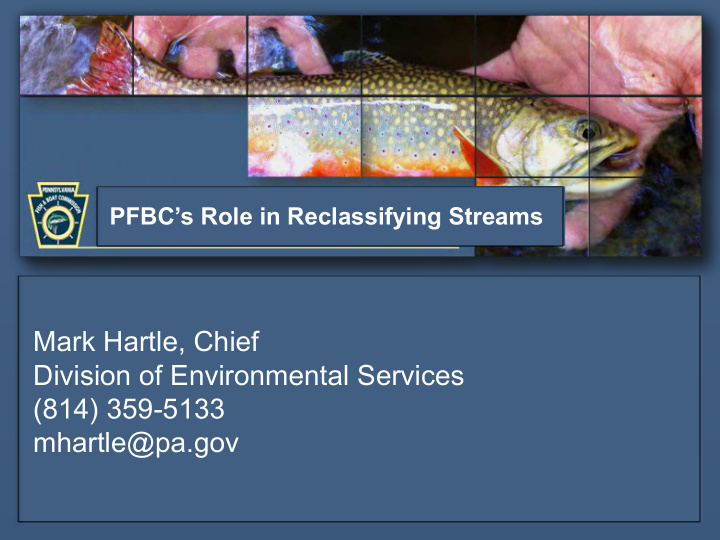



PFBC’s Role in Reclassifying Streams Mark Hartle, Chief Division of Environmental Services (814) 359-5133 mhartle@pa.gov
Issues before AAB What is the process used in identifying and reclassifying streams? What is the process used in picking streams to assess and reclassify? How do PFBC and DEP interact with each other in use if these classifications?
Process to Identify and Reclassify Streams PFBC routine surveys for fishery management purposes Targeted surveys to determine the nature of an unknown resource in a potential project area Unassessed Waters Initiative
Pennsylvania’s Unassessed Waters Initiative • To date, approximately 53,000 waters in Pennsylvania have not been surveyed • Most are small first and second order streams • Proper classification through biological surveys is necessary to accurately reflect the aquatic communities that reside in these streams • Permitted activities consider accurate resource risks
Unassessed Waters Initiative Goal: Proactively identify and properly classify the most at-risk streams which support naturally reproducing trout populations in order to protect, conserve and enhance those waters as wild trout streams.
Strategic Trout Plan Priority Issue #1 “The PFBC has not assessed all of the streams throughout the Commonwealth. As a result, the total number of streams that support wild trout populations in Pennsylvania is unknown, which leads to inadequate protection for these streams. The PFBC does not currently have the ability to assess the most at-risk streams at a rate that would outpace the rate of degradation.”
Unassessed Waters Initiative 2010 to Present • PFBC Bureau of Fisheries – Develops list each year of waters to be sampled by staff and cooperators. Staff conduct surveys in field season. • Cooperators - Developed and implemented pilot program with two colleges. Expanded to nine partners in 2011, fifteen in 2013. Varies between 12 – 15 partners annually.
Unassessed Waters Initiative – Partners
Picking Streams to Assess • Develop a means to involve interested partners in identifying wild trout populations in unassessed waters. • Use GIS technology to identify potential wild trout streams (watersheds) most at risk. • Develop prioritized lists of unassessed streams.
Scope of the Issue Division of Fisheries Management
Division of Fisheries Management
Unassessed Waters Initiative – 2013 Priority Watersheds Division of Fisheries Management
Sampling Procedures • Site located < 0.5 miles from mouth • Water Quality Testing • Fish Sampling - Electrofishing • Site Length ~ 100 meters (328 ft)
Pennsylvania’s Flowing Water Resources - 2008 Surveyed Sections Unassessed Sections
Pennsylvania’s Flowing Water Resources - 2014 Surveyed Sections Unassessed Sections
Implications of Wild Trout Designation • Supports a minimum designated use of Cold Water Fishes ( 25 Pa Code, Ch. 93 ) • Streams with greater biomass of wild trout may qualify for special protection* • Wetlands associated with floodplain are designated as Exceptional Value (EV) wetlands ( Ch. 105 ) • Greater public knowledge of commonwealth’s resources *Class A designation qualify waters for special protected use High Quality, Cold Water Fishery (HQ-CWF)
Process Used to “Pick” Streams to Reclassify
58 PA Code, §57.11 Listing of Wild Trout Streams § 57.11. Listing of wild trout streams. (a) Maintenance of list. (b) Criteria for classifying wild trout streams. (1) Location and habitat. (2) Exclusion of stocked trout. (3) Biological criteria. In identifying a wild trout stream, the investigator should find one or more of the following:
Qualification to be Listed as a Wild Trout Water: Three (3) Wild Trout captured of one species All Young-of Year (< 150 mm; 6 inches) or Representative of two age classes
58 PA Code, §57.11 Listing of Wild Trout Streams § 57.11. Listing of wild trout streams. (4) Tributary linkages. Tributaries to wild trout streams are classified as wild trout streams for their function as habitat for segments of wild trout populations, including nurseries and refuges, and in sustaining water quality necessary for wild trout. This section cited in 25 Pa. Code § 105.1 (definitions).
Tributary Linkages (58 Pa Code, Ch. 57.11)
Wild Trout Designations - Process Surveys/Data Collection Wild Trout Criteria met? If Yes? Narrative written. Reviewed internally Listed on website as being by CWU Leader – FM Division Chief - considered for Wild Trout Bureau of Fisheries Chief Designation (6 months) BOF Chief Signature
Listed on website as being Agenda item written. Posted in Officially proposed for Wild the Pennsylvania Bulletin for Trout Designation Public Comment. + 60 Days Proposed Wild Trout Designations voted on by Commission List of PA Stream Sections that Support Natural Reproduction of Trout
Stream Sections That Support Natural Reproduction of Trout
25 PA Code, §93.4b Qualifying as High Quality or Exceptional Value Waters (a) Qualifying as a High Quality Water. A surface water that meets one or more of the following conditions is a High Quality Water. (1) Chemistry. (2) Biology. One or more of the following shall exist: (i) Biological assessment qualifier. (ii) Class A wild trout stream qualifier. The surface water has been designated a Class A wild trout stream by the Fish and Boat Commission following public notice and comment.
Listed on website as being Agenda item written. Posted in Officially proposed for Class the Pennsylvania Bulletin for A Wild Trout Designation Public Comment. + 60 Days Proposed Class A Wild Trout Designations voted on by Commission List of Class A Wild Trout Waters
Class A Wild Trout Waters
Suggestion 3
PFBC/DEP Interaction Wild trout – PFBC makes list available. DEP considers if existing or designated use is CWF Wetlands considered EV under Chapter 105 Class A Wild Trout PFBC advances listings DEP considers existing use and whether to change designated use to HQ EQB votes on streams for final rulemaking
Questions? Mark Hartle, Pennsylvania Fish and Boat Commission Phone: 814-359-5133 E-mail: mhartle@pa.gov
Recommend
More recommend